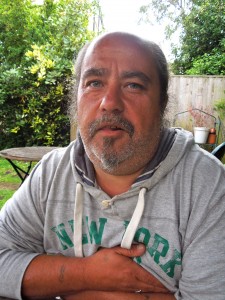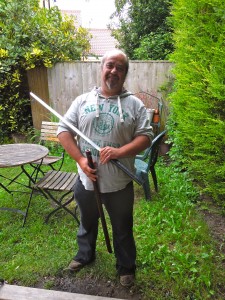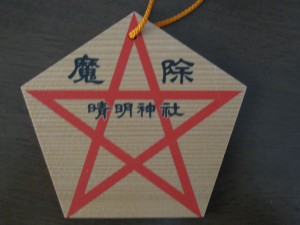
John Howard, neo-pagan and Shinto sympathiser
Some people in the West come to an interest in Shinto through martial arts. Some through their sympathy with nature religions and neo-paganism. John Howard, featured here, combines both elements.
You’re Ovate of Glastonbury. Can you explain what that means?
It’s one of the offices of modern Druids, responsible for initiating and carrying out projects for the group. Druids preach peace and respect for nature – it’s more a philosophical path than a religion really. We hold circles and ceremonies, but they’re open to anyone from any faith. We meet at full moon or special days of the pagan calendar, such as Beltane which is our main festival when we carry a red and white dragon down the High Street in honour of Glastonbury’s Red and White Springs.
What form do the Druid ceremonies take usually?
It all depends on the occasion of course, but usually we form a loose circle and ask the elemental forces of the four directions to join us and give their blessing. Then we intone the Awen (three sounds which resonate round the circle in harmony). We intone an oath of peace three times, then it depends on the purpose of the meeting really. We might tell stories, or sing songs, or recite poems for instance.
How did your interest in martial arts develop?
Well, I learnt judo from the age of eight, and then jujitsu (rougher and older). it led me to read everything I could about them and martial arts in general. Around 16 I met an aikido teacher and started learning from him. The philosophy of ‘loving protection of all things’ really appealed to me, and so I started reading more about the founder Ueshiba Morihei. And my other big hero is swordsman Miyamoto Musashi, as I also practise kendo and iaido (way of the sword).

John Howard with a Japanese sword forged in Glastonbury, site of ancient Avalon and the legendary Excalibur
From the age of 16 I was working at Peckforton Castle in Cheshire doing reenactments of medieval life and fighting. Later I spent about 25 years teaching medieval weaponry, including that of Japanese bushi warriors. I feel like I was born with a sword in my hand, and I find that the principles of swordsmanship are not just valid across West and East but apply to any situation of life, really.
How did you come to an awareness of Shinto?
Well, as I said, I was drawn to the philosophy of Ueshiba and also to Daoism, which is like the Chinese version of Shinto. What I find appealing is the spirit of Shinto, if not the formal side of the ritual ~ the wonder of nature, the respect for lineage and ancestors. A lot of the culture of the sword for instance is about swords having a kami. I like that idea. And kotodama (word magic) is very much like the Bardic thinking in Druidry. Actually Druidry and Shinto are very close, it’s amazing. They both see the world in similar ways.
Here in Glastonbury we’ve started an interfaith initiative and currently there are 53 members, all of whom belong to different sects and beliefs. The idea is to work towards mutual understanding and further the cause of peace. The city council here are very open and supportive, so it’s a receptive place at the moment. The pagan shrines at White Spring and the Goddess Temple have all got going in the last ten years, so I think the time is ripe for Shinto to start something too. Even though I’ve never been to Japan, I feel a strong connection with the culture. Perhaps it’s something to do with a previous life. You can’t explain these things.

Magical pentagram uniting east and west. Here depicted as Daoist wizard Abe no Seimei's sign, the pentagram also forms the witch's symbol signifying the five elements.

Leave a Reply